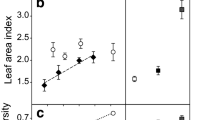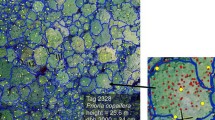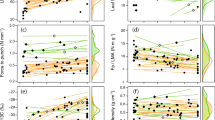The species richness (number of vascular plants per hectare) of Australian plant communities (containing a mosaic of gap, regeneration, maturation and senescent phases) is correlated with the annual biomass productivity of the overstorey canopy.
The annual production of leaves and stem in the canopy of the plant community is shown to be limited by the requirements of photosynthesis (particularly light and the availability of water) and the length of the growing season.
The species richness of Australian plant communities is the product of the blance between the dominance of the overstorey and the response of the understorey to the shading of the overstorey. For all climatic regions and zones the species richness of the overstorey of the plant community is shown to be exponentially related to the annual shoot growth of the overstorey canopy, until the latitudinal or altitudinal tree line is reached. With latitudinal increase outside the tropics, overstorey canopies of forest communities absorb increasingly more of the incident solar radiation. markedly reducing the species richness of the understorey strata. In contrast, in these latitudes the overstorey of plant communities with widely spaced trees or tall shrubs will absorb far less solar radiation, thus enabling the species richness of the understorey to be maintained.
Similar content being viewed by others

References
Ashton, D.H. (1976) The development of even-aged stands in Eucalyptus regnans F. Muell. in central Victoria. Austr. J. Bot. 24, 397–414.
Batianoff, G.N. and Specht, R.L. (1992) Queensland (Australia) serpentinite vegetation. In The Vegetation of Ultramatic (Serpentine) Soils (J. Proctor, A.J.M. Baker and R.D. Reeves, eds). Andover: Intercept Publications.
Braithwaite, R.W., Winter, J.W., Taylor, J.A. and Parker, B.S. (1985) Patterns of diversity and structure of mammalian assemblages in the Australian tropics. Aust. Mammalogist 8, 171–86.
Bureau of Meteorology, Commonwealth of Australia (1975a). Climatic Averages (States and Territories of Australia). Metric Edition. Australian Government Publication Service: Canberra.
Bureau of Meteorology, Commonwealth of Australia (1975b). Climatic Atlas of Australia. Map Set 2. Global Radiation. Australian Government Publication Service.
Busby, J.R. (1984) Nothofagus cunninghamii (Southern Beech) Vegetation in Australia. Canberra: Australian Flora and Fauna Series No. 1, Bureau of Flora and Fauna.
Charles-Edwards, D.A., Doley, D. and Rimmington, G.M. (1986) Modelling Plant Growth and Development. Sydney: Academic Press.
Connell, J.H. and Orias, E. (1964) The ecological regulation of species diversity. Amer. Nat. 98, 399–441.
Fox, M.D. (1988) Species richness of plant communities in southwestern New South Wales, Australia. In Mediterranean-type Ecosystems. A Data Source Book. (R.L. Specht, ed.) pp. 82. Dordrecht: Kluwer Academic Publishers.
Grime, J.P. (1979) Plant Strategies and Vegetation Processes. Toronto: Wiley.
Hopkins, B. (1955) The species-area relations of plant communities. J. Ecol. 43, 409–26.
Hounam, C.E. (1969) Revised regression equations for estimation of solar radiation over Australia. Austr. Meteorol. Mag. 17, 91–4.
Howard, T.M. and Ashton, D.H. (1973) The distribution of Nothofagus cunningharnii rainforest. Proc. Royal Soc. Victoria 86, 47–75.
Huston, M. (1979) A general hypothesis of species diversity. Am. Nat. 113, 81–101.
Kramer, P.J. and Kozlowski, T.T. (1979) Physiology of Woody Plants. New York: Academic Press.
MacArthur, R.H. (1969) Patterns of communities in the tropics. In Speciation in Tropical Environments. (R.H. Lowe-McConnell, ed.) pp. 19–30. Academic Press: New York.
Margalef, R. (1969) Diversity and stability: a practical proposal and a model of interdependence. Brookhaven Symp. Biol. 22, 25–37.
Nicholson, D.I., Henry, N.B. and Rudder, J. (1988) Stand changes in north Queensland rainforests. Proc. Ecol. Soc. Australia 15, 61–80.
Noble, I.R. and Slatyer, R.O. (1977) The effect of disturbances on plant succession. Proc. Ecol. Soc. Australia 10, 135–45.
Pianka, E.R. (1966) Latitudinal gradients in species diversity: a review of concepts. Am. Nat. 100, 33–46.
Rice, B. and Westoby, M. (1983) Plant species richness at the 0.1 hectare scale in Australian vegetation compared to other continents. Vegetatio 52, 129–40.
Specht, A. (1985) Temperature Effects on Eucalypt Shoot Growth in the Brisbane Region. PhD Thesis, The University of Queensland, St Lucia, Queensland.
Specht, R.L. (1958) The climate, geology, soils and plant ecology of the northern portion of Arnhem Land. In Records of the American-Australian Scientific Expedition to Arnhem Land. Vol. 3. Botany and Plant Ecology. (R.L. Specht and C.P. Mountford, eds) pp. 333–414. Melbourne: Melbourne University Press.
Specht, R.L. (1972) Water use by perennial overgreen plant communities in Australia and Papua New Guinea. Aust. J. Bot. 20, 273–99.
Specht, R.L. (1981a) Growth indices — their role in understanding the growth, structure and distribution of Australian vegetation. Oecologia (Berlin), 50, 347–56.
Specht, R.L. (1981b) Ecophysiological principles determing the biogeography of major vegetation formations in Australia. In Ecological Biogeography of Australia. (A. Keast, ed.) pp. 299–332. Junk: The Hague.
Specht, R.L. (1986) Functioning of tropical plant communities: Phenology. In Tropical Plant Communities. Their Resilience, Function and Management in Northern Australia. (H.T. Clifford and R.L. Specht, eds) pp. 78–90. Utah Foundation and Botany Department, The University of Queensland: St Lucia, Queensland.
Specht, R.L. (1988) Climatic control of ecomorphological characters and species richness in Mediterranean ecosystems of Australia. In Mediterranean-type Ecosystems. A Data Source Book. R.L. Specht, (ed.) pp. 149–55. Dordrecht: Kluwer Academic Publishers.
Specht, R.L. and Morgan, D.G. (1981) The balance between the foliage projective covers of overstorey and understorey strata in Australian vegetation. Aust. J. Ecol. 6, 193–202.
Specht, R.L. and Specht, A. (1989a) Canopy structure in Eucalyptus-dominated communities in Australia along climatic gradients. Acta Oecol. Plant. 10, 191–213.
Specht, R.L. and Specht, A. (1989b) Species richness of overstorey strata in Australian plant communities — the influence of overstorey growth rates. Aust. J. Bot. 37, 321–36.
Specht, R.L. and Specht, A. (1989c) Species richness of sclerophyll (heathy) plant communities in Australia — the influence of overstorey cover. Aust. J. Bot. 37, 337–50.
Specht, R.L., Salt, R.B. and Reynolds, S.T. (1977) Vegetation in the vicinity of Weipa, North Queensland. Proc. Royal Soc. Queensland 88, 17–38.
Specht, R.L., Grundy, R.I. and Specht, A. (1990) Species richness of plant communities — relationship with community growth and structure. Israel J. Bot. 39, 465–80.
Specht, R.L., Clifford, H.T., Arianoutsou, M., Bird, L.H., Bolton, M.P., Forster, P.I., Grundy, R.I., Hegarty, E.E. and Specht, A. (1991) Structure, floristics and species richness of plant communities in southeast Queensland. Proc. Royal Soc. Queensland 101, 27–78.
Spencer, J.W. (1965a) Calculation of solar position for building purposes. CSIRO Australian Divisiton of Building Research Technical Paper No. 14.
Spencer, J.W. (1965b). Estimation of solar radiation in Australian localities on clear days. CSIRO Australian Division of Building Research Technical Paper No. 15.
Taylor, B.W. (1955) The flora, vegegation and soils of Macquarie Island. Australian National Antarctic Research Expeditions Reports. Series B. Vol. 2. Botany.
Watt, A.S. (1947) Pattern and process in the plant community. J. Ecol. 35, 1–22.
Yount, J.L. (1956) Factors that control species numbers in Silver Springs, Florida. Limnol. Oceanog. 1, 286–95.
Author information
Authors and Affiliations
Rights and permissions
About this article
Cite this article
Specht, A., Specht, R.L. Species richness and canopy productivity of Australian plant communities. Biodivers Conserv 2, 152–167 (1993). https://doi.org/10.1007/BF00056131
Received:
Accepted:
Issue Date:
DOI: https://doi.org/10.1007/BF00056131



